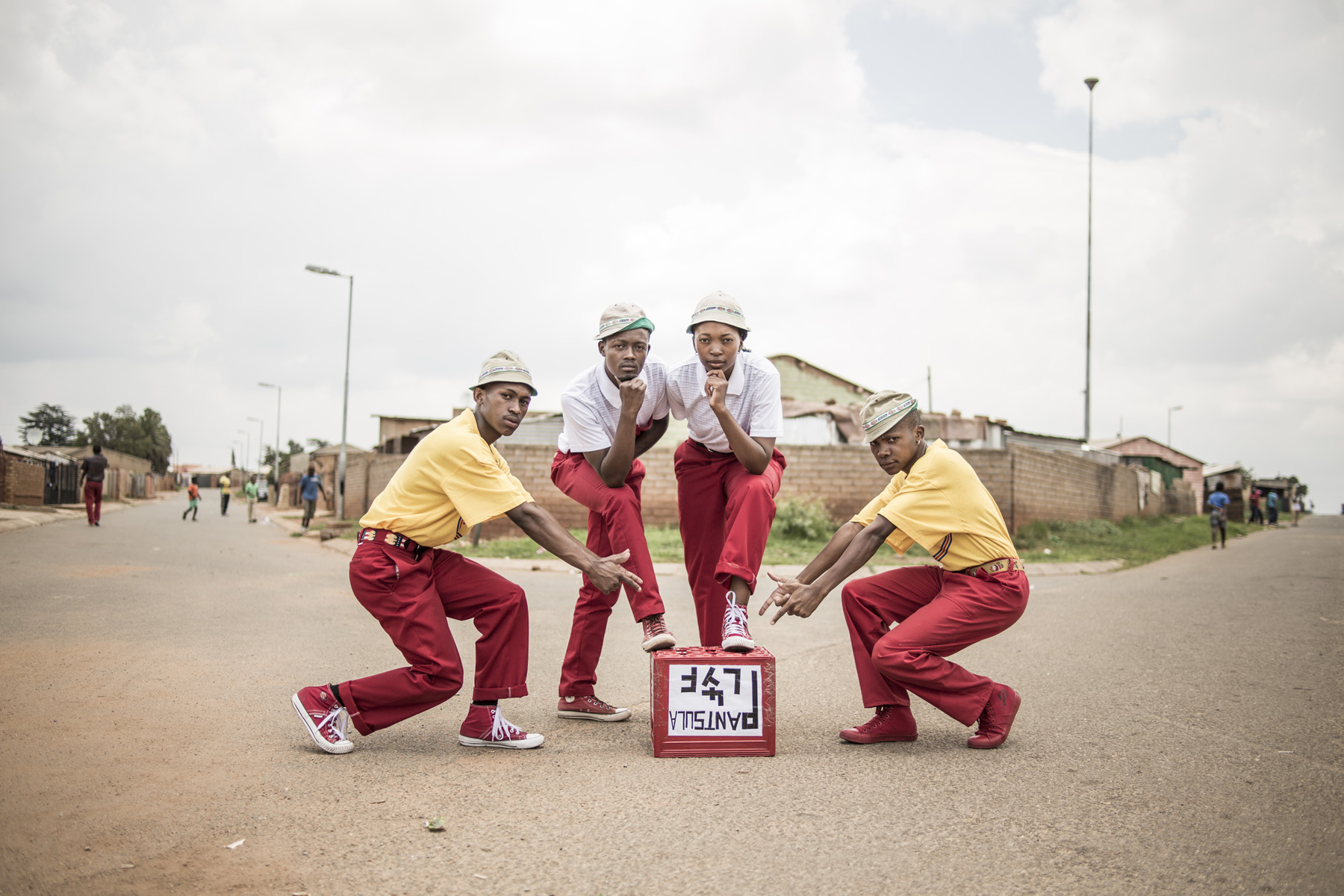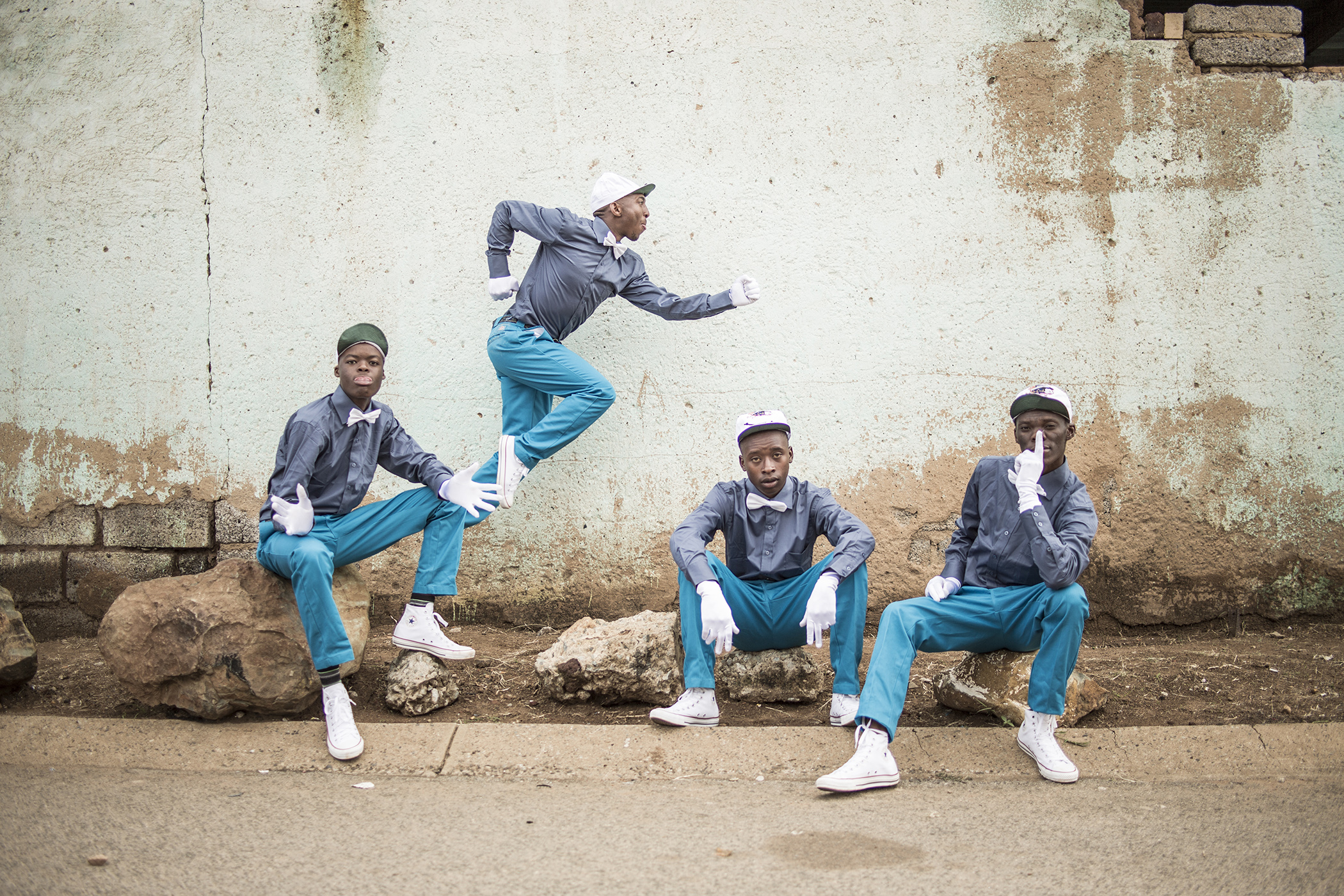Exhibition Review: PANTSULA 4 LYF: Popular Dance and Fashion in Johannesburg
Fowler Museum at UCLA (January 29 - May 7, 2017)
A dancing man greets visitors from a flat screen monitor installed near the gallery entrance. Smiling, he slides his Converse-clad feet across the ground and taps his toes. A yellow bucket hat crowns his head. His citrus-colored workwear dances along with his movements, the bright colors providing a vivid contrast with the brown dirt beneath his feet. This video installation introduces PANTSULA 4 LYF: Popular Dance and Fashion in Johannesburg. The exhibition on view at UCLA’s Fowler Museum tells the story of a contemporary dance culture through vibrant portraits of dancers, crews, and their styled outfits captured in photos by Chris Saunders. Documented against the backdrop of township outdoor spaces such as brick walls, empty lots, and rusted cars, as well as performing for their respective communities, Saunders deftly captures the intimate relationship between the pantsula community and the overlooked and ordinary spaces and places—both rural and urban—of Johannesburg.
Pantsula is the name of a dance culture originating in the black townships of South Africa during Apartheid. Dancers within this community perform choreographed dances in small groups outdoors in public spaces and in organized competitions. The exhibition’s press release explains, “Pantsula, which in Zulu means ‘to waddle like a duck,’ influences how members of the dance crews talk, dress and move.” The portraits on view focus on the fashion of pantsula, a look distinguished by colorful combinations of American inspired work wear often including Converse shoes, Dickies work pants, and collared shirts in bright hues. Crewmembers dance and dress in coordination—wearingidentical uniforms that distinguish each crew with a unique take on the recognizable pantsula workwear style.
Chris Saunders, a white South African photographer with a background in fashion photography, began documenting pantsula dancers in 2010, after meeting the dance company Real Actions Pantsula from Orange Farm. In his artist statement, Saunders explains how, “being of the same generation as most of the current pantsula crew leaders and having lived through the transformation of South Africa from apartheid to democracy with them, but totally separated from them, I am fascinated by the way space and time transform realities and change perceptions.”
The Fowler Museum at UCLA, part of UCLA’s School of the Arts and Architecture, focuses on global arts and cultures, with the museum’s largest exhibition showcasing a collection of work emerging from Africa, Asia, the Pacific, and the Americas. PANTSULA 4 LYF, organized by Assistant Curator of African Arts, Erica P. Jones, explores a contemporary dance culture born in the townships of black South Africa. Jones conceived the exhibition as“a meditation on the everyday experiences of township life, though the themes have changed.”
Spread across the first floor of the museum and encircling a small outdoor courtyard that houses a dry fountain and potted plants, Saunders’ photographs pop from the gallery’s white walls. Each wall contains a theme: Hola Malume: The Old Guard; Lacing Up: Fashion; Pantsula Today; and Movement. Unframed portraits are mounted on stiff backing and hang on clips from thin metal chords—like photographs drying in a darkroom. This presentation emphasizes the portraits as a part of a whole body of work rather than a collection of individual photographs, as the cables draw lines around the gallery walls, leading the viewer through a linear narrative.
The text on the first wall provides a brief history of pantsula, positioning the scene as a cultural youth movement that has endured and evolved with the times since the 1970s. The first photographs on view introduce the so-called "Old Guard," or men who performed pantsula in the ‘80s and ‘90s. These men wear dark colors and mix fedoras, leather jackets, and dress shoes into their ensembles. Their outfits stand out since they are the only subjects of the exhibition who do not wear the contemporary pantsula look.
The title of the second wall, Lacing Up: Fashion, introduces an exploration into the dress practices associated with pantsula. “The styles worn by pantsulas…are signifiers of a dancer’s place within the township pantsula subculture. Pantsula fashion has always been an important marker of identity and resistance.” The text breaks down the uniform into a few key and highly specific elements: “Dickies trousers, Converse All Star sneakers, and a cap with a small brim.” The crews all wear the same unique outfit for performances. Both men and women participate in pantsula, although the subjects of the exhibit are mostly male. According to the text, the gender-neutral looks shown in PANTSULA 4 LYF are unique to the past 25 years, “prior to the 1990s women would dress in distinctly feminine attire.” From its inception, pantsula fashion has looked to American styles for inspiration and the contemporary is no exception. To American eyes, the pantsula practice of wearing work wear (clothing designed to be utilitarian) looks particularly fresh. Pantsula is not the first subculture to reinterpret work wear with new meaning, but with a focus on color and coordination it may be the most vibrant.
The third wall, Pantsula Today, is the strongest collection of photographs on view. Meeting the different crews through group portraits conveys the visual power of pantsula fashion as it’s meant to be viewed—as a coordinated group uniform. Capturing the dancers posed with their crews or performing in front of an audience, these photographs feel more like documentary work rather than street style fashion photography. The act of performance comes into focus in a set capturing the crews dancing for the community. An image of the crew Rozary Productions from Dukathole, shows the trio of dancers in matching outfits standing high above their audience on industrial structures used as platforms. The men wear white gloves, holding their hands to the sky while a group of small children look up, watching from below.
The final wall, Movement, focuses on the dance style that characterizes pantsula. Taking a cue from Eadweard Muybridge, Saunders shows two contact sheets capturing an individual dancer’s movements frame by frame. The wall text explains that pantsula is a method of storytelling, describing the choreography itself as composed of “elements of daily life in Johannesburg’s townships.” Gestures like raising an arm to hail a bus or jumping from a moving train to a platform are exaggerated into choreography.
Saunders’ compositions utilize setting only as background, relegating visual focus to his subjects and their clothing. As described on his website, “Saunders' work typically conveys an upbeat energy. He doesn't so much ignore surrounding political and social problems, as relegate them to the background, against which his subjects' boundless creativity generates an irrepressible optimism.”
Yet, with any venture into anthropology, the relationship of documentarian to subject is easily problematic. In this case, Chris Saunders is a white South African who was born in Johannesburg. Other than geography, the black South Africans he photographs grew up in an entirely different world. While his highly-stylized images could be interpreted as replicating an outsider’s gaze, the mediums he has chosen could also be construed as a bridge for exploring two sides of the Apartheid legacy. While Saunders depicts pantsula culture as young and bright, the body of work begs the question: What would we see from a photographer within the townships?




